A Detailed Look At The Mayan Train Project in Mexico
Table of Contents
- 1 A Detailed Look At The Mayan Train Project in Mexico
- 2 What is the Mayan Train and where will it be built?
- 3 What will the Mayan Train be like?
- 4 How much will the Mayan Train tickets cost?
- 5 What is the route that the Mayan Train will follow?
- 6 What benefits might the Tren Maya bring?
- 7 Objections to the Maya Train Project in Mexico
- 8 How will the Mayan Train affect the Riviera Maya?
- 9 When will the Mayan Train be completed?
UPDATE: The Mayan Train is operational between Cancun and Palenque on a limited basis. Buy your tickets online here.
Buy Tren Maya Tickets OnlineIf you live in Mexico or have traveled to Mexico, especially to the Yucatan Peninsula, in the past few years, you have undoubtedly heard about the Tren Maya. It’s a daily topic in the news and it’s on everyone’s lips. You are unlikely to find a topic as divisive as the Mayan Train Project with both sides lobbying squarely for (President Andrés Manuel López Obrador, contractors and stakeholders) or against it (environmentalists, archeologists and sociologists).
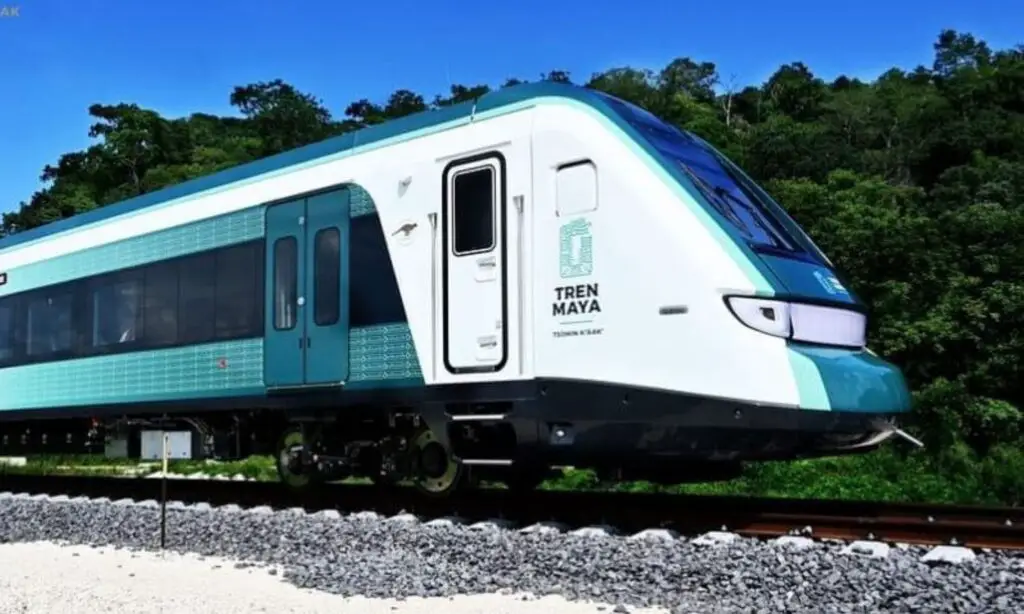
It’s been frustrating to keep up with all the changes to this ambitious project and it seems until the railcars are running on the tracks, nothing is set in stone. Here is what we know right now.
What is the Mayan Train and where will it be built?
The Mayan Train (Tren Maya), is a new touristic attraction now being built on the Yucatan Peninsula, in southern Mexico. The Mayan Train project was announced in September 2018 by Mexico’s then-President-elect Andrés Manuel López Obrador. Despite much opposition, AMLO was able to push through and construction of the Maya train officially began in 2020.
Watch this video to see more.
The entire route of the Tren Maya is approximately 1,500 km long and will pass through 40 municipalities and 181 towns in the states of Chiapas, Tabasco, Campeche, Yucatán and Quintana Roo. The route for the Tren Maya has been divided into seven sections: Jungle One, Gulf One, Gulf Two, Gulf Three, Caribbean One, Caribbean Two, and Jungle Two. Throughout these seven sections, there will be 21 main stations and 14 stops (paraderos).
What will the Mayan Train be like?
The Mayan Train will circumnavigate the Yucatan peninsula using a combination of diesel and electric trains. These high-speed trains have been designed for a top velocity of 160 km/hour for passenger travel and 100 km/hour for freight and cargo. The Mayan Train project will cover tourism services, transport for local passengers, and cargo transportation. Railcars will be adapted to accommodate these distinct purposes.
The tourist class and long-distance cars will have rooms for overnight stays and restaurants with typical food from the southeast region of Mexico. Thirty-one of the forty-two trains will be used for basic passenger service, eight will be especially for touristic purposes, and three for long-distance travel.

The passenger locomotives will be divided into three categories: Xiinbal (Walking), Janal (Eat), and P’atal (Stay). Each category will cater to different passenger needs, including local transit passengers, tourists, and long-distance travelers.
The three levels of the Mayan Train passenger service are detailed as follows:
Xiinbal (Walking)
The basic passenger service will have panoramic windows to admire the scenery, standard seats, business class seats and a cafeteria.
Janal (Eat)
Service with different seating configurations and restaurants with food and beverages typical to the regions through which the Mayan Train passes. There will be tables for two and four people.
P’atal (Stay)
Designed for long distances and to enjoy the tourist and cultural sites along the route. The rail cars will feature reclining seats and sleeping cabins with a private bathroom, shower and intercom.
How much will the Mayan Train tickets cost?
Friday, September 1st, the Mayan Train will begin its first trial run and at the end of this year, it is expected to begin offering its full range of services. Many have been wondering what the prices will be to board this transport.
While no official rates have been published on the government website, one director revealed that the Tren Maya will cost 2.32 per kilometer for locals. Foreigners will be charged at a higher rate. The charts below will give you an idea of the cost to travel from one station to another.
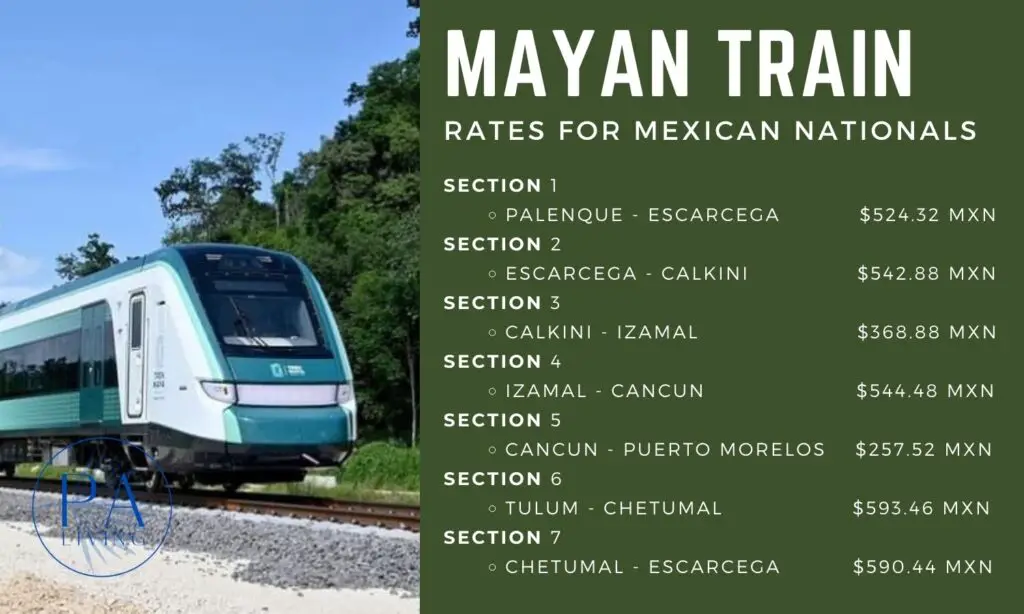
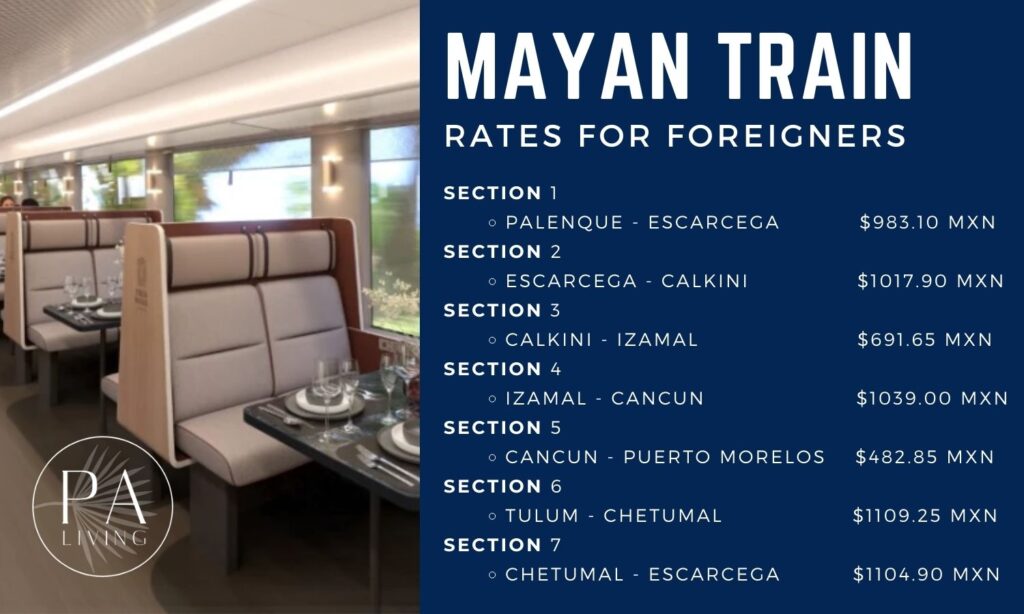
The Tren Maya will offer free transportation services for certain sectors of the population. Senior citizens, retirees, pensioners, children under 5 and the handicapped will be able to ride the Mayan Train for free. On Saturdays, children up to age 10 will be able to ride the train without charge.
At this time it is unclear if foreigners with permanent residency in Mexico will be offered a discount for travel on the Mayan Train or qualify for any free services.
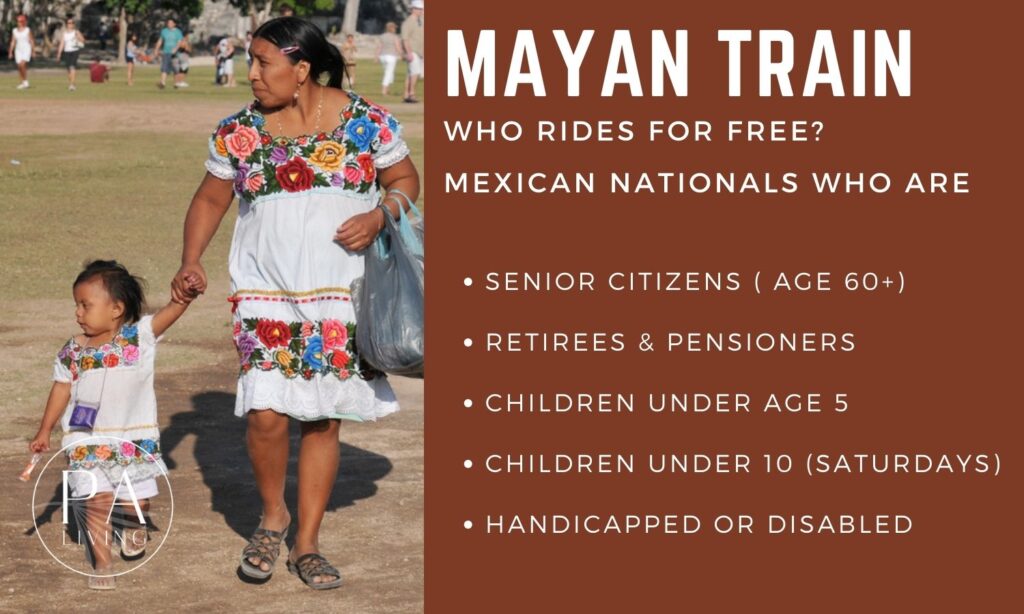
What is the route that the Mayan Train will follow?
Forty-two trains with a total of 219 cars will encircle the Yucatan peninsula. The route of the Mayan Train has been divided into three main regions: Selva (Jungle), Caribe (Caribbean) and Golfo (Gulf). Traversing these three sections there are seven distinct stretches of track with 21 Stations and another 14 Stops (paraderos).
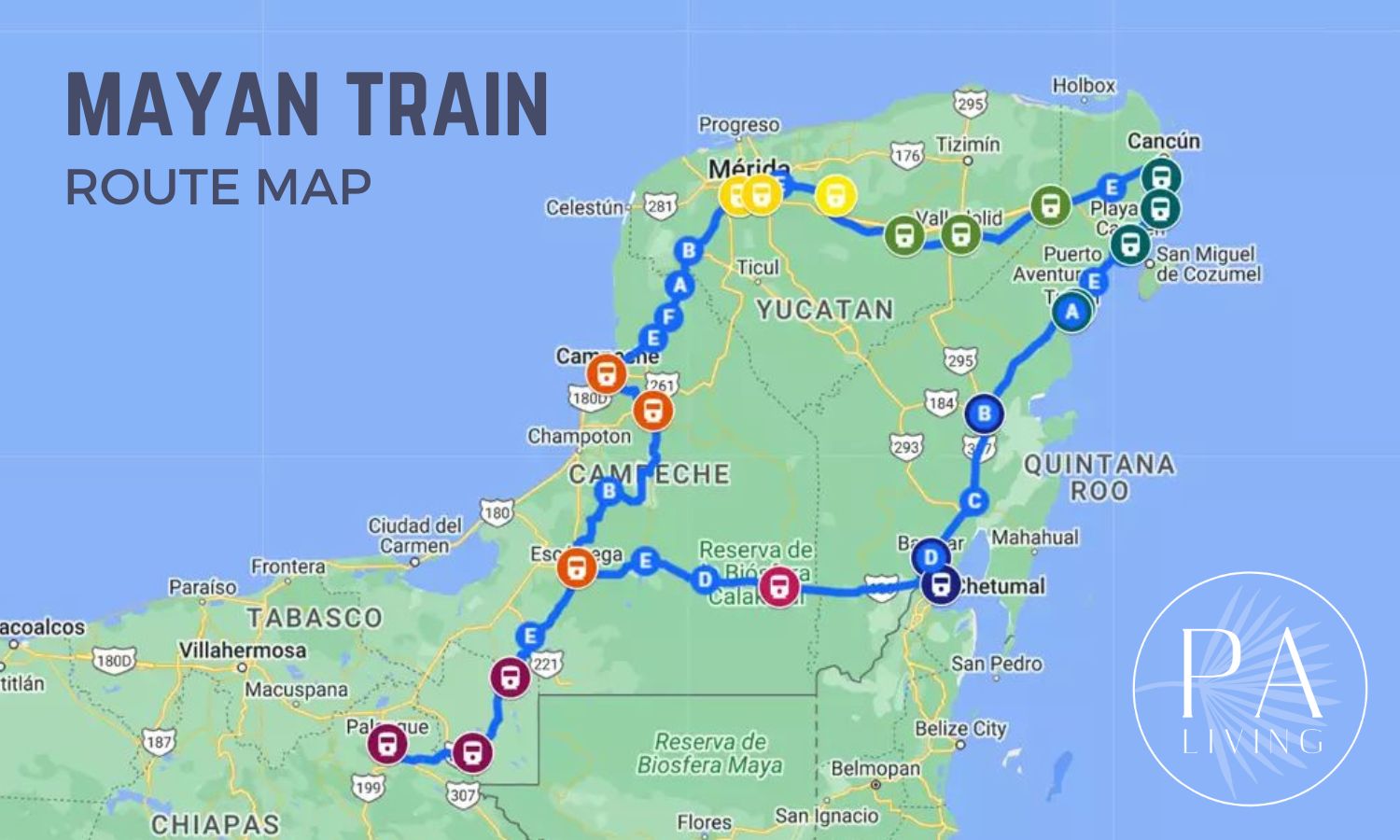
The Mayan Train route is as follows:
Section 1 Jungle (Selva) One
Jungle One: Palenque – Escárcega (228 kilometers)
Stations (Palenque, Boca del Cerro, El Triunfo) and Stops (Tenosique, Candelaria)
Section 2 Gulf (Golfo) One
Gulf One: Escarcega – Calkiní (235 kilometers)
Stations (Escárcega, Edzná, San Francisco de Campeche) and Stops (Carrillo Puerto)

Section 3 Gulf (Golfo) Two
Gulf Two: Calkiní – Izamal (172 kilometers)
Stations (Mérida, Teya, Izamal) and Stops (Mexcanú, Tixkokob).
Section 4 Gulf (Golfo)Three
Gulf Three: Izamal – Cancun Airport (257 kilometers)
Stations (Chichén Itzá, Valladolid, Nuevo Xcán) and Stops (Xibalbá, Leona Vicario)
Section 5 Caribbean (Caribe) One
Gulf Three: Cancun Airport – Tulum Airport (121 kilometers)
Stations (Cancún Airport, Puerto Morelos, Playa del Carmen, Tulum, Tulum Airport) and Stops (Xcaret, Puerto Aventuras, Akumal)
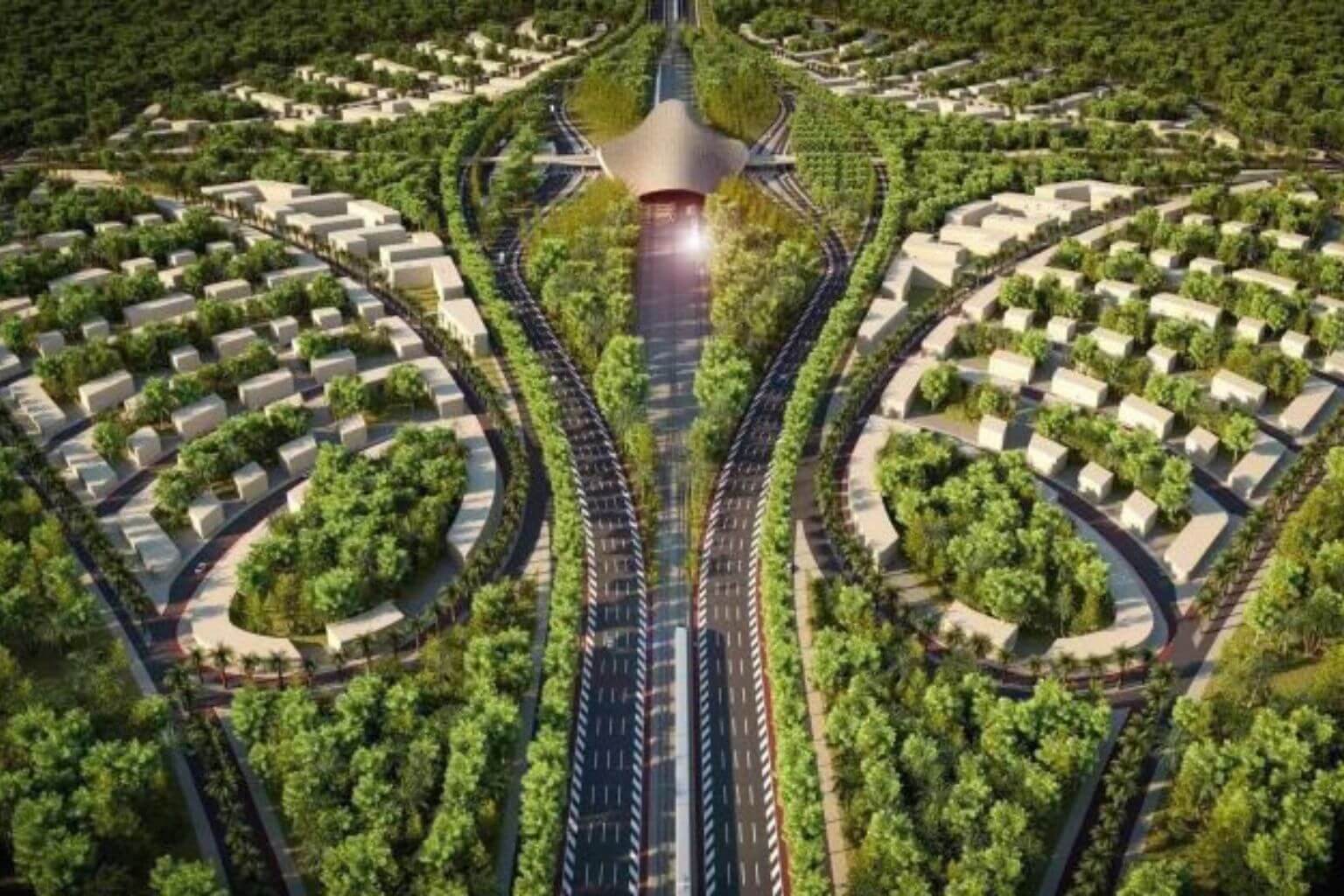
Section 6 Caribbean (Caribe) Two
Caribbean Two: Tulum Airport – Chetumal (254 kilometers)
Stations (Felipe Carrillo Puerto, Bacalar, Chetumal Airport) and Stops (Limones)
Section 7 Jungle (Selva) Two
Jungle Two: Chetumal – Escarcega (287 kilometers)
Stations (Xpujil) and Paraderos (Conhuas, Centenario)
Each stop along the train line will provide passengers with the opportunity to explore the local area, visit important archaeological sites, historical and cultural landmarks, and experience the local cuisine and way of life. Proponents claim the Tren Maya is designed to be a sustainable and eco-friendly way to explore the diverse and rich culture of Mexico’s Yucatán Peninsula.
Along the route, passengers will be able to reach 46 important archaeological zones including Chichén Itzá, Tulum, Calakmul, Uxmal, Edzná, and Palenque. The train will pass through 28 rural communities, 18 destinations designated as Indigenous Paradises, 14 Pueblos Magicos )Magical Towns), and 6 areas that have been named UNESCO World Heritage Sites.
Watch this video to see more.
What benefits might the Tren Maya bring?
Proponents of the Mayan Train project claim that once completed, the train could bring many benefits to the Yucatan Peninsula, including:
Increased tourism
The Mayan Train is expected to attract more tourists to the region, boosting local economies and creating new jobs. It is hoped that the Tren Maya will help distribute the tourism dollars that are predominantly spent in beach resorts to other less accessible areas in southeastern Mexico.
Improved transportation
The train lines will connect many major cities and popular destinations in the region, making it easier for all people to travel and explore the Yucatan Peninsula. The railway project will connect well-established tourist destinations with small towns and villages in its path as it traverses the Yucatan peninsula.
Preservation of cultural heritage
The Mayan Train may help to promote the preservation of cultural heritage and support sustainable tourism in the region. As of January 2021, workers and archeologists had discovered dozens of hidden ancient ruins, uncovering and preserving thousands of artifacts and structures.
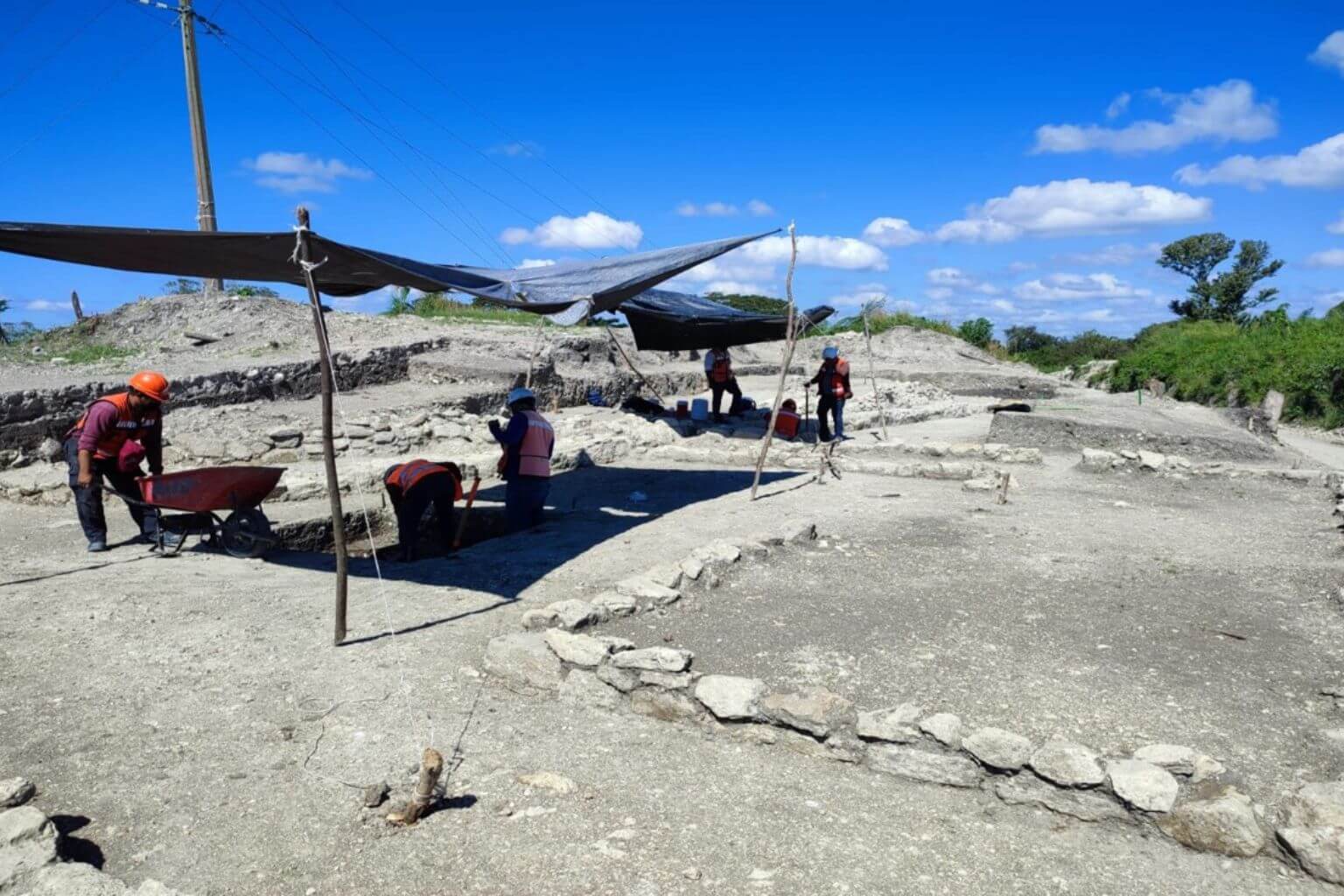
Improved infrastructure
The construction of the train will also lead to the improvement of existing infrastructure and the development of new infrastructure in remote parts of Mexico that can benefit from it.
Access to new markets
The Maya Train project could provide access to new markets for local businesses, helping to spur economic growth across the region.
Objections to the Maya Train Project in Mexico
While the Tren Maya has the potential to bring many benefits to the Yucatan Peninsula, the Mayan Train project has definitely been met with strong resistance. Environmentalist activists argue that the construction of the train will have permanent negative impacts on our fragile ecosystems that can never be abated.
Here are some of the important issues to consider.
Irreparable Environmental Damage
Deforestation, destruction of wildlife habitats, and the pollution of waterways vital to the regions where the train has been built have already been documented. The stretch of tracks planned above the Sac Actun aquifer and other ancient cave systems is of grave concern and its environmental impact uncertain. Environmental scientists point to the lack of environmental risk assessments as a red flag in the development of this train.
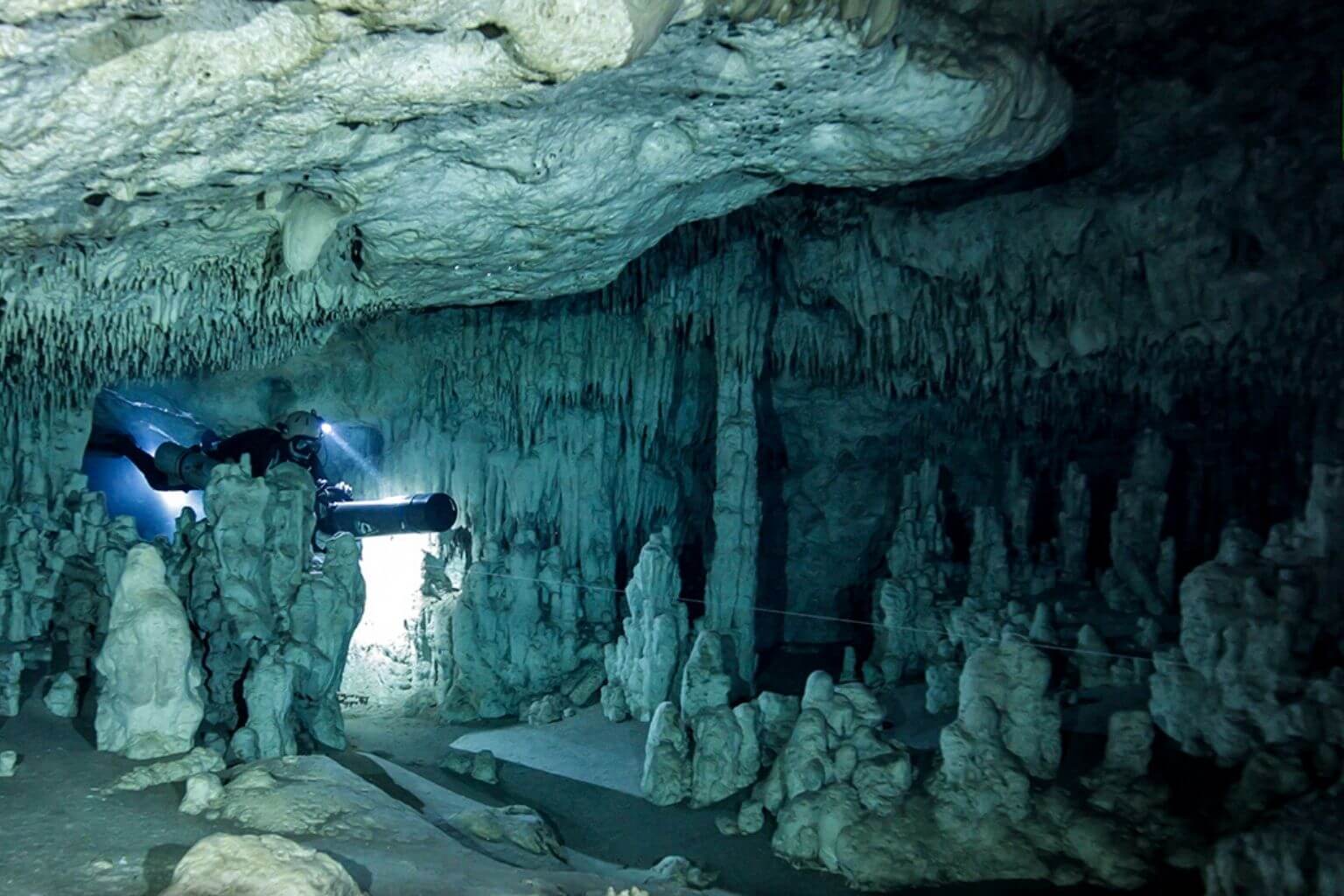
Displacement of indigenous communities
Some fear that the construction of the train will lead to the displacement of indigenous communities and the loss of their traditional lands. Some indigenous Maya living in remote southern jungles actively avoid contact with the outside world, protecting their traditional way of life. The Tren Maya may bring unwanted attention that will not benefit these communities.
Lack of planning
Train lines have been haphazardly initiated only to be changed and rerouted time and again. Lack of proper planning, inadequate site evaluations and hasty construction have already led to the unnecessary destruction of jungles and roadways and the disruption of traffic.
Lack of transparency
From the beginning, there have been concerns about the lack of transparency in the planning and development and indeed the grand purpose of the Maya Train project. Many feel that the government has not consulted adequately with local communities and other stakeholders.
Unproven financial viability
There are concerns about the financial viability of the project and whether it will be able to generate enough revenue to be self-sustaining in the long term. A definitive pricing scheme has yet to be released which leaves many unanswered questions.
Some worry that the Maya Train project will exacerbate existing social inequalities and tensions between different communities in the region.
Destroy cultural heritage
There are concerns that the increased access the Mayan Train will bring, could inadvertently harm important cultural heritage sites and damage the cultural identity of the indigenous peoples in the region.
How will the Mayan Train affect the Riviera Maya?
It remains to be seen how the Tren Maya will affect day-to-day life and tourism development on the Riviera Maya. Frequent travelers to this region hope that the train will offer a faster and more affordable means of transportation up and down the Riviera Maya corridor, particularly from the airport in Cancun to destinations such as Playa del Carmen, Puerto Aventuras, Akumal and Tulum.
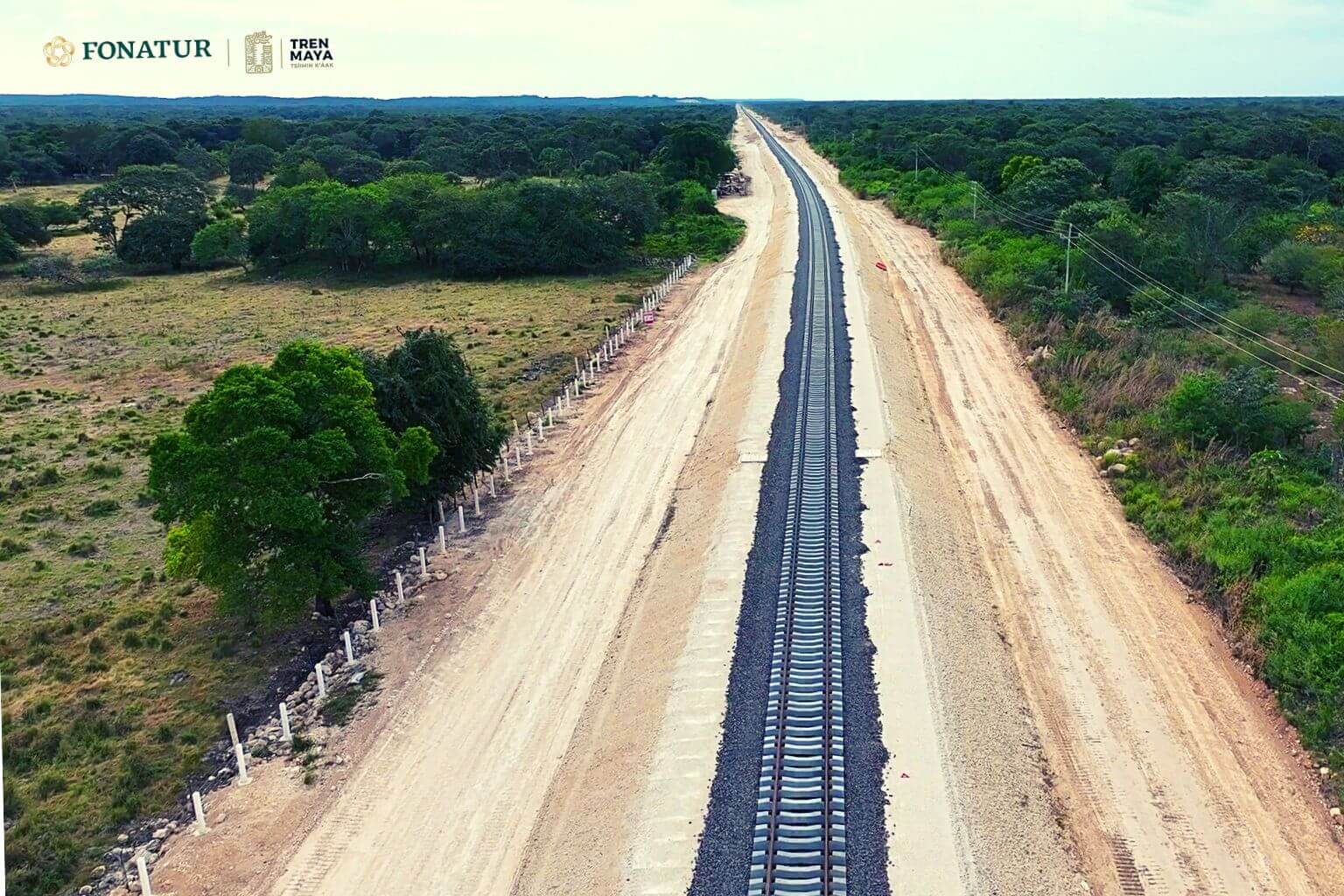
Last year, when it appeared as if sections of the Tren Maya project would run straight down the middle of 307, it seemed possible that the train might offer a viable means of local transportation, perhaps alleviating traffic on 307. When the train was rerouted several kilometers into the jungle it left most of us scratching our heads about whether this train would offer any kind of convenient transport between the towns from Cancun to Tulum.
At the moment, the railway line is run so far inland that travelers will need to take a taxi to actually access the cities and sites that the train is supposed to connect. What the taxi rates will be to and from the stations and paraderos is anyone’s guess and may negate any cost savings the train offers.
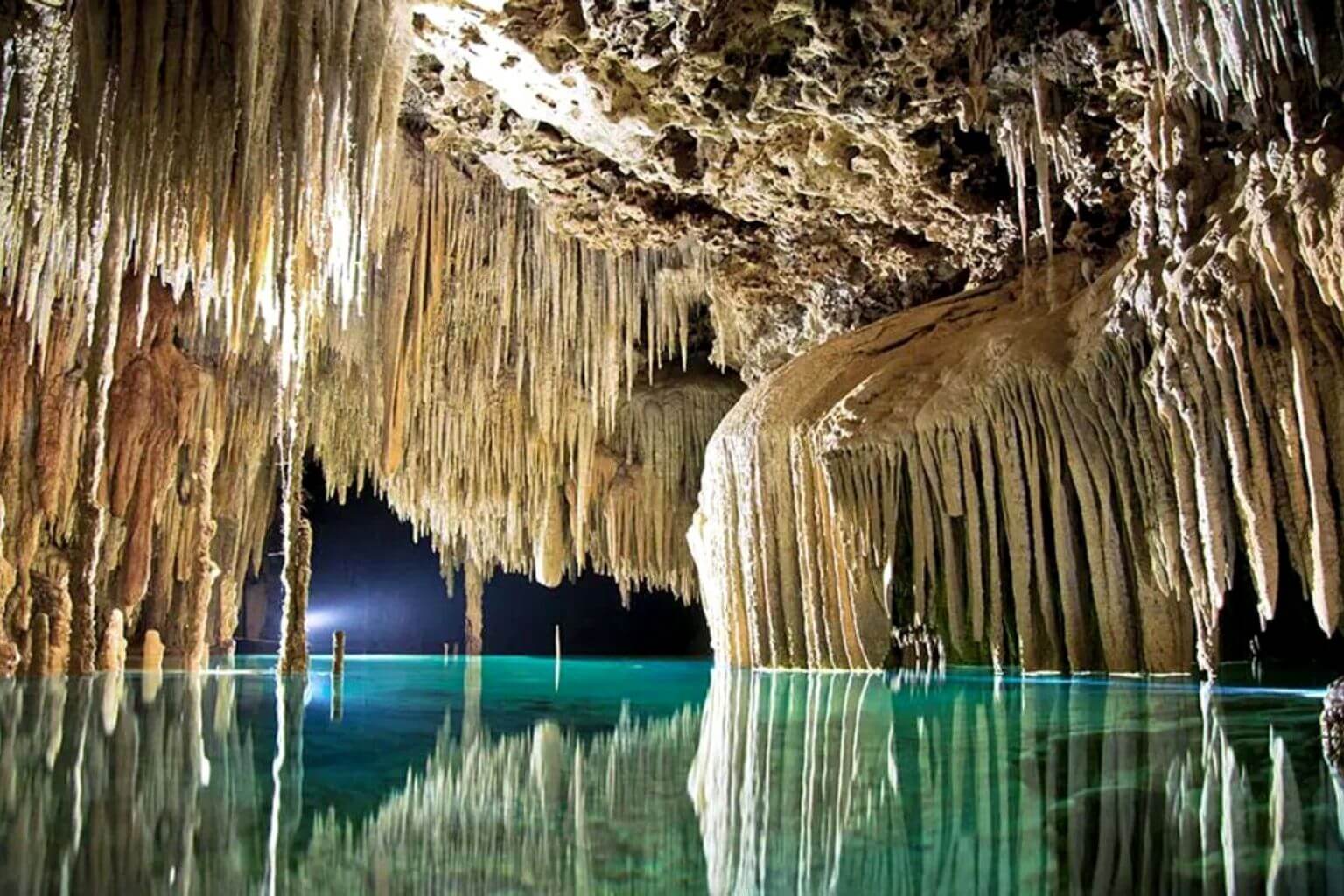
Undoubtedly, the most troubling effect of the Mayan Train may be the destruction of the Riviera Maya’s most significant treasures; its elaborate underground water system and cenotes. We have yet to see any plans that do NOT include running the tracks over the top of the Sac Actun water system, the longest contiguous underground river system in the world. There have been some plans to elevate the tracks in delicate areas. We have heard of the tracks being designed with a “cushion” set on the jungle floor to absorb the vibrations of the railcars.
Environmental activists have been successful in their efforts to bring attention to the potential damage the Tren Maya could cause and its negative impact on the natural areas especially along the Riviera Maya corridor. There have been many stop-work orders and injunctions to halt the progress of this stretch of track (Section 5) until a suitable solution can be found but ultimately, the train will go forward and we are left crossing our fingers about the long-term effects.
When will the Mayan Train be completed?
The railway´s current status remains unfinished but President López Obrador asserts that the tourist train will be 100% complete prior to the end of his term in 2024.
Currently, it is being reported that the Tren Maya route from Cancun to Campeche will be operating on December 15. The tracks from Cancun to Palenque will open on December 31. On February 29, construction and testing on the entire Yucatan circuit should be complete and the trains operational.
Construction of the Mayan Train continues but the passenger trains were already tested in July 2023. The estimated total cost of this ambitious project, including 30 years of operations and maintenance (but not including electrification), is over 320 billion pesos.
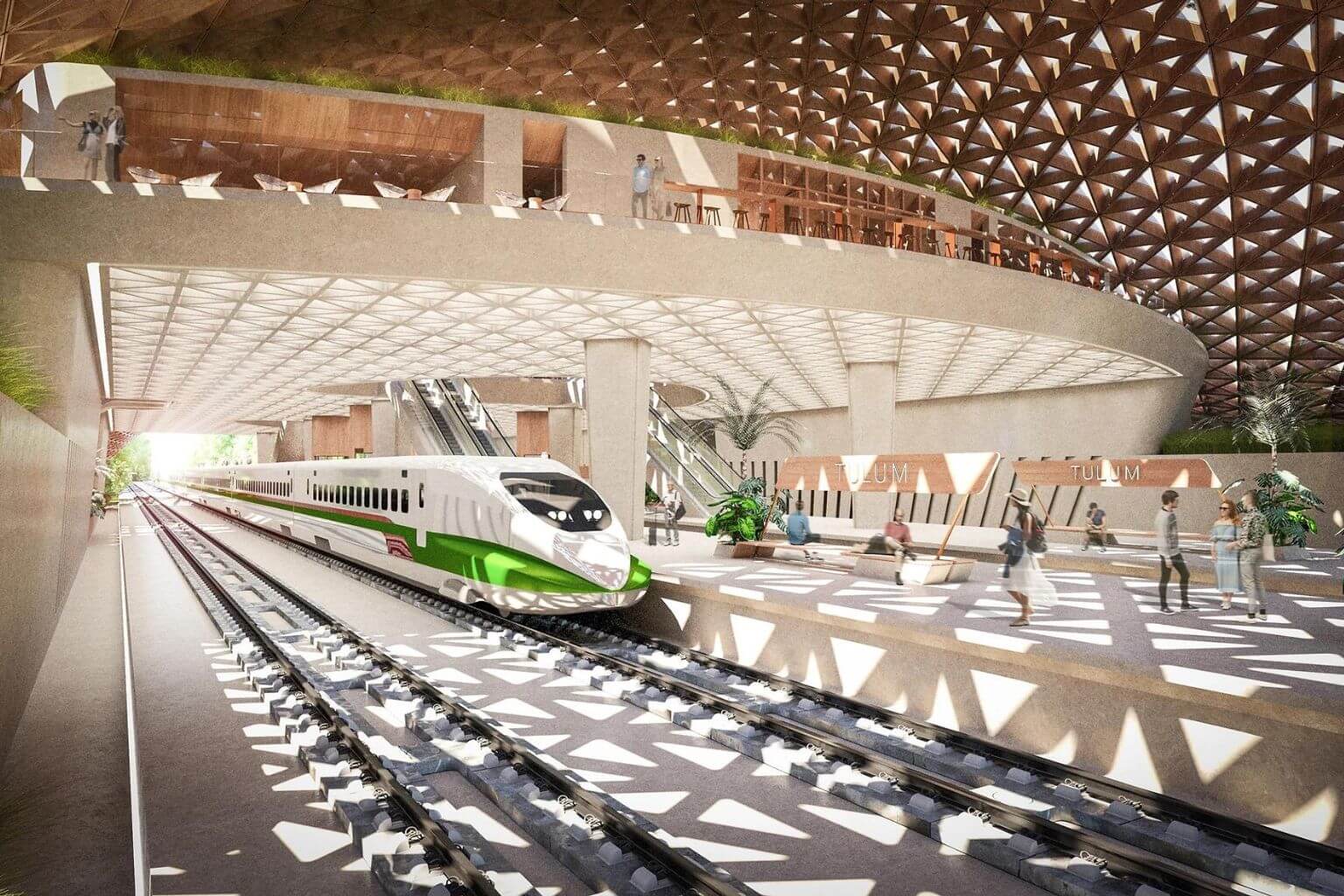
While AMLO and the Mexican government promise that the Mayan Train will bring economic development and assist in the promotion of tourism across the Yucatan Peninsula, there are valid environmental concerns and questions about its potential negative impact on local communities. The lack of transparency and public participation in the decision-making process has also raised doubts about the project’s true motives and benefits.
It remains to be seen whether the Tren Maya will fulfill its promises or become another example of a poorly planned and executed infrastructure project that only benefits a select few. Until then, it is crucial to approach this project with a healthy dose of skepticism and continue to monitor its progress carefully.
Regardless of how I personally feel about the Mayan Train project (its true purpose and who will benefit from it) at this point, so much damage has been done and so much money has been spent, if it is NOT completed and NOT a success, what a waste and a shame that would be. I hope the powers that be can put their agendas and their egos aside and figure out a way to finish the path of the train with the appropriate caution and consideration.
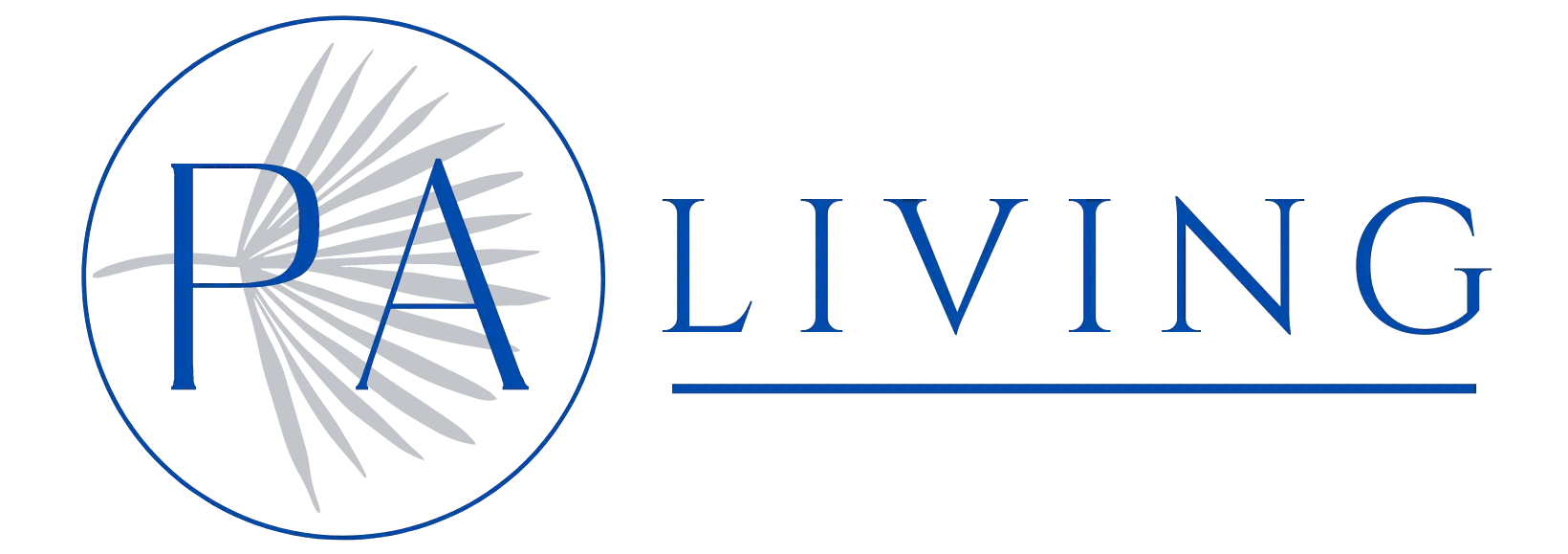

So many articles on Maya Train. So far i have not seen any confirmation to schedule. Will we be able to,travel this train from Merida to Palenque this January?
There are very few actual fotos of An Tren-Maya construction or details of completion of rail or stations of maintenance shops or operational centres.
This is troublesome as we approach the end of 2023.